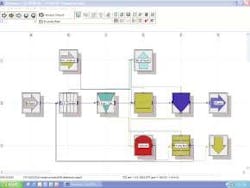Predicting VOC Emissions Using General Fate Models
By Mary Hewitt Daly
The Clean Air Act Amendments (CAAA) of 1990 will significantly affect industrial wastewater treatment facilities and publicly owned treatment works (POTWs). Of the 11 titles that comprise the CAAA, Titles I, III, and V are especially important to these wastewater treatment facilities.
These titles require wastewater treatment facilities to identify sources and quantify emissions of nitrogen oxides (NOx), volatile organic compounds (VOC), and hazardous air pollutants (HAP).
Because of this, wastewater treatment facilities will need to determine if their facility is affected by the CAAA. Although most POTWs are expected to be minor sources, all municipal POTWs will have to identify and quantify emission sources.
The best approach to determine if a wastewater facility is affected by the CAAA is to conduct an emission inventory, primarily by estimating air emissions from all sources, including fugitives. Potential air emission sources at a typical wastewater treatment facility include engines, boilers, incinerators, and wastewater and solids handling unit processes.
Methods that are available to estimate air emissions include stack/field testing, published emission factors, engineering equations, and a new method called general fate modeling (GFM).
General Fate Models
GFMs are computational models that perform a mass balance around each specified wastewater unit operation and certain solids handling facilities, as well as the whole wastewater treatment facility. The development of GFMs for air emissions was prompted by the complexity and high cost of direct air sampling and measurement from wastewater treatment facilities.
Most GFMs estimate pathway sources (influent and recycle loadings) and losses through the facility (volatilization, stripping, adsorption onto solids which are subsequently separated and removed for disposal, biodegradation, and pass through in the effluent) from the wastewater stream.
Using GFMs, it is possible to estimate emissions from complex treatment configurations while considering split flows, liquid streams, quiescent surfaces, weirs, drops, as well as aerated, biological, and covered processes or any single operation or process. These models report the mass of each organic compound that is emitted into the atmosphere, the portion that is biodegraded and passed through in the effluent.
Required Data
GFMs are designed to be specific to the wastewater treatment facility and particular operation in question. Knowledge of facility-specific data is critical to set up and run one of these models. The facility data can be divided into three groups presented below:
Influent Wastewater Characteristics - includes wastewater flow rate, temperature, VOC concentrations, total and volatile suspended solids, ambient temperature and wind speed.
Physical Design Characteristics - such as unit process dimensions (length, width, depth, etc.), weir characteristics, and other features (are processes covered or open to the atmosphere?)
Operational Data - including the type of biological treatment, air flow rates, ventilation rates of covered processes, RAS and WAS rates, dissolved oxygen concentration, etc.
Advantages
GFMs are widely accepted for estimating emissions generated from wastewater treatment facilities. The EPA will accept emission estimates from certain GFMs (stated below). GFMs are particularly advantageous when projecting potential emissions under varying existing and future flow and design conditions.
GFMs can be employed as an important planning tool for understanding where emissions are released, what compounds are emitted the most, how emissions may change, what alternatives are effective in reducing emissions, and the "what ifs" related to emissions when a facility is planning to expand and/or change certain wastewater operations.
Certain GFMs have developed sensitivity analyses that allow facility operators to estimate air emission impacts when varying any of the inputted data (for example wastewater flow, VOC concentration, weir length, etc.) within a range.
Several GFMs with varying degrees of sophistication have been developed for wastewater treatment facilities.
Available Models
The GFMs specified by the Environmental Protection Agency (EPA) in the regulations entitled Hazardous Organic National Emission Standards for Hazardous Air Pollutants (HON) are TOXCHEM+, Bay Area Sewage Toxic Emissions (BASTE 4.0), and WATER9.
TOXCHEM+, developed by Enviromega Ltd. and the Wastewater Technology Centre with the financial sponsorship of Environment Canada and the Ontario Ministry of Energy and Environment, runs under a Microsoft Windows operating environment and is the most comprehensive, user-friendly of the three models.
BASTE is a model developed for a consortium of POTWs (Bay Area Air Toxics BAAT group) in California. WATER9 is a model developed under a USEPA contract. Both TOXCHEM+ and BASTE are proprietary models while WATER9 is available on the EPA bulletin board.
Choosing a Model
Although all three models may be successfully used to estimate air emissions from wastewater treatment facilities, some caution should be taken when choosing among these GFMs and interpreting their results.
In general, the algorithms for these three models are the same but some of the assumptions made for each model may vary, giving different results.
For example, an ongoing Malcolm Pirnie study comparing the models shows that TOXCHEM+ and BASTE predicted statistically similar results when compared to each other and to field measurements to a specific POTW. WATER9 estimated significantly higher emissions than the other two models.
About the Author: Mary Hewitt Daly is a Senior Air Quality Project Engineer with Malcolm Pirnie, Inc. She can be reached at [email protected].

